Deck 5: Capacity
Question
Question
Question
Question
Question
Question
Question
Question
Question
Question
Question
Question
Question
Question
Question
Question
Question
Question
Question
Question
Question
Question
Question
Question
Question
Question
Question
Question
Question
Question
Question
Question
Question
Question
Question
Question
Question
Question
Question
Question
Question
Question
Question
Question
Question
Question
Question
Question
Question
Question
Question
Question
Question
Question
Question
Question
Question
Question
Question
Question
Question
Question
Question
Question
Question
Question
Question
Question
Question
Question
Question
Question
Question
Question
Question
Question
Question
Question
Question
Question

Unlock Deck
Sign up to unlock the cards in this deck!
Unlock Deck
Unlock Deck
1/143
Play
Full screen (f)
Deck 5: Capacity
1
The Northern Manufacturing Company is producing products A and B, using the same machine called MASAC27A. Demand forecasts for next year and other production- related information are provided in the following table.

The company works 250 days per year and operates 2 shifts each day, each shift covering 8 hours. If 25 percent of capacity cushion is maintained throughout the year, how many machines (MASAC27A) does the company need next year to meet the demand? Round your answer up to the next whole machine.
A) fewer than 11 machines
B) 11 machines
C) 12 machines
D) more than 12 machines

The company works 250 days per year and operates 2 shifts each day, each shift covering 8 hours. If 25 percent of capacity cushion is maintained throughout the year, how many machines (MASAC27A) does the company need next year to meet the demand? Round your answer up to the next whole machine.
A) fewer than 11 machines
B) 11 machines
C) 12 machines
D) more than 12 machines
12 machines
2

Using the information in Table 5.4, if Lee expands the capacity to an equivalent of $360,000 sales now (year 0), how much would pretax cash flow in year 1 increase because of this expansion?
A) less than $3000
B) more than $3000 but less than $5000
C) more than $5000 but less than $7000
D) more than $7000
less than $3000
3
A wait- and- see strategy in regard to capacity is best characterized by
A) reducing the risks of lost sales due to capacity constraints.
B) making large, infrequent jumps in capacity expansions.
C) reducing the risks of over optimistic demand forecasts.
D) using capacity as a competitive weapon in order to compete on cost.
A) reducing the risks of lost sales due to capacity constraints.
B) making large, infrequent jumps in capacity expansions.
C) reducing the risks of over optimistic demand forecasts.
D) using capacity as a competitive weapon in order to compete on cost.
reducing the risks of over optimistic demand forecasts.
4
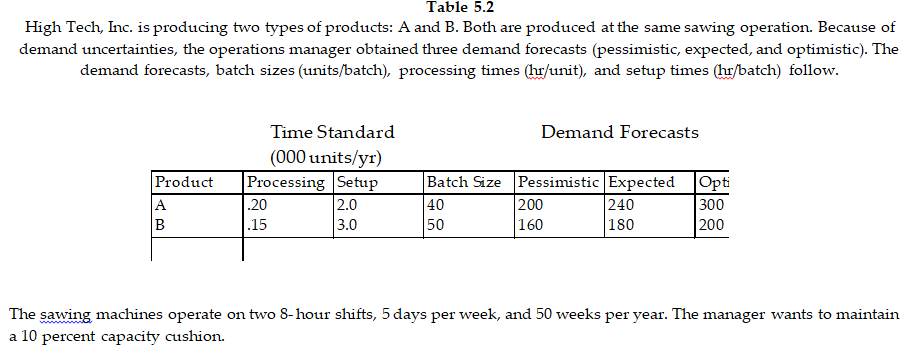
Using the information from Table 5.2, what is the minimum total number of hours required of sawing equipment for the next year?
A) less than 85,000 hours
B) more than 85,000 but less than 95,000
C) more than 95,000 but less than 105,000
D) more than 105,000 hours

Unlock Deck
Unlock for access to all 143 flashcards in this deck.
Unlock Deck
k this deck
5
What information would managers use to choose the best cost- effective capacity to balance customer service with the cost of adding capacity?
A) capacity cushion
B) decision trees
C) waiting line models
D) economies of scale
A) capacity cushion
B) decision trees
C) waiting line models
D) economies of scale

Unlock Deck
Unlock for access to all 143 flashcards in this deck.
Unlock Deck
k this deck
6
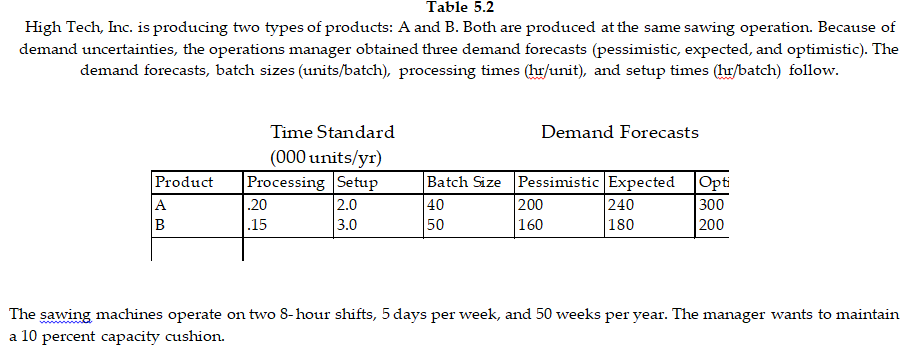
Using the information from Table 5.2, what is the maximum number of machines needed (assuming no reliance on short- term option)?
A) less than or equal to 25
B) more than 25 but less than or equal to 28
C) more than 28 but less than or equal to 31
D) more than 31

Unlock Deck
Unlock for access to all 143 flashcards in this deck.
Unlock Deck
k this deck
7
Which of the following is NOT a disadvantage of the wait- and- see strategy?
A) being unable to respond if demand is unexpectedly high
B) can erode market share over the long run
C) can be preempted by a competitor
D) increased risk of over expansion
A) being unable to respond if demand is unexpectedly high
B) can erode market share over the long run
C) can be preempted by a competitor
D) increased risk of over expansion

Unlock Deck
Unlock for access to all 143 flashcards in this deck.
Unlock Deck
k this deck
8
The single milling machine at Stout Manufacturing was severely overloaded last year. The plant operates eight hours per day, five days per week, and 50 weeks per year. Management prefers a capacity cushion of 15 percent. Two major types of products are routed through the milling machine. The annual demand for product A is 3000 units and 2000 units for product B. The batch size for A is 20 units and 40 units for B. The standard processing time for A is 0.5 hours/unit and 0.8 for B. The standard setup time for product A is 2 hours and 8 hours for product B. How many new milling machines are required if Stout does not resort to any short- term capacity options?
A) no new machines
B) 1 or 2 new machines
C) 3 or 4 new machines
D) more than 4 new machines
A) no new machines
B) 1 or 2 new machines
C) 3 or 4 new machines
D) more than 4 new machines

Unlock Deck
Unlock for access to all 143 flashcards in this deck.
Unlock Deck
k this deck
9
Which one of the following is NOT a reason why there are economies of scale?
A) Better bargaining position and quantity discounts on purchased materials
B) Spreading fixed costs, such as depreciation and debt service, over more units
C) Finding process advantage by dedicating resources to individual products
D) Reduced construction costs by building smaller facilities
A) Better bargaining position and quantity discounts on purchased materials
B) Spreading fixed costs, such as depreciation and debt service, over more units
C) Finding process advantage by dedicating resources to individual products
D) Reduced construction costs by building smaller facilities

Unlock Deck
Unlock for access to all 143 flashcards in this deck.
Unlock Deck
k this deck
10
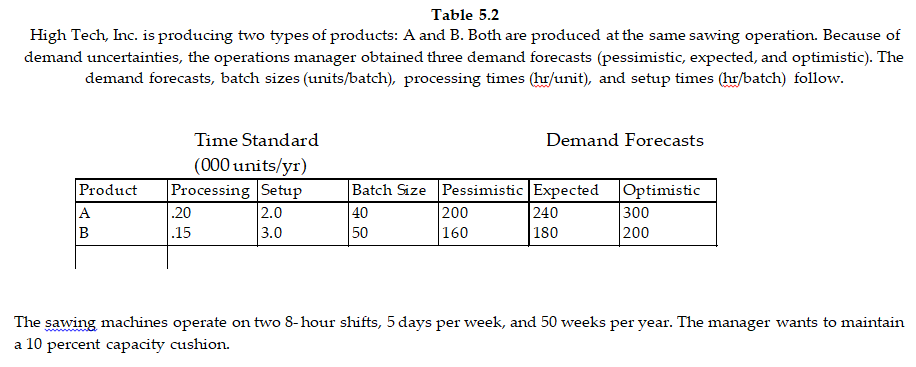
Using the information from Table 5.2, if the operation currently has 18 machines and the manager is willing to expand capacity by 20 percent through short- term options, what is the capacity gap (in terms of number of machines) if you assume the optimistic demand forecasts?
A) less than or equal to 10
B) more than 10 but less than or equal to 12
C) more than 12 but less than or equal to 14
D) more than 14

Unlock Deck
Unlock for access to all 143 flashcards in this deck.
Unlock Deck
k this deck
11
Up, Up & Away is a producer of kites and windsocks. Relevant data concerning their production for the upcoming fiscal year are as follows:  Assume: 1 shift/day, 8 hours/shift, 5 days/week, and 50 weeks/year.
Assume: 1 shift/day, 8 hours/shift, 5 days/week, and 50 weeks/year.
There currently are four machines, and management wants a capacity cushion of 20 percent.
Which of the following alternatives will enable Up, Up & Away to meet all of the upcoming year's demand using the minimum number of machines?
A) add six additional machines
B) add five additional machines
C) add four additional machines
D) add three additional machines
 Assume: 1 shift/day, 8 hours/shift, 5 days/week, and 50 weeks/year.
Assume: 1 shift/day, 8 hours/shift, 5 days/week, and 50 weeks/year. There currently are four machines, and management wants a capacity cushion of 20 percent.
Which of the following alternatives will enable Up, Up & Away to meet all of the upcoming year's demand using the minimum number of machines?
A) add six additional machines
B) add five additional machines
C) add four additional machines
D) add three additional machines

Unlock Deck
Unlock for access to all 143 flashcards in this deck.
Unlock Deck
k this deck
12
Which one of the following statements about capacity cushion is best?
A) Return of investment is about the same for capital- intensive firms, regardless of their capacity cushions.
B) Large capacity cushions are more likely to be utilized when future demand is known.
C) Small cushions are used when the product mix often changes.
D) The best- sized cushion varies by industry and firm.
A) Return of investment is about the same for capital- intensive firms, regardless of their capacity cushions.
B) Large capacity cushions are more likely to be utilized when future demand is known.
C) Small cushions are used when the product mix often changes.
D) The best- sized cushion varies by industry and firm.

Unlock Deck
Unlock for access to all 143 flashcards in this deck.
Unlock Deck
k this deck
13
Innovative Inc. is experiencing a boom for the products it has introduced recently. The estimated annual sales projected for the next five years are given below. The current capacity is equivalent to only $100 million sales. The company is considering the alternative of expanding capacity to an equivalent of $250 million sales. Assume a 25 percent pretax profit margin. What is the increase in total pretax cash flow (summed over all years) that would be enjoyed because of the expansion? 
A) less than or equal to 40 million
B) more than 40 million but less than or equal to 70 million
C) more than 70 million but less than or equal to 100 million
D) more than 100 million

A) less than or equal to 40 million
B) more than 40 million but less than or equal to 70 million
C) more than 70 million but less than or equal to 100 million
D) more than 100 million

Unlock Deck
Unlock for access to all 143 flashcards in this deck.
Unlock Deck
k this deck
14
Which of the following statements about bottlenecks is best?
A) Increasing bottleneck capacity does not increase plant capacity.
B) When capacities are perfectly balanced, it can be said that every operation is a bottleneck.
C) Floating bottlenecks are most likely to occur with line flow processes.
D) Floating bottlenecks are created by stability in the workload.
A) Increasing bottleneck capacity does not increase plant capacity.
B) When capacities are perfectly balanced, it can be said that every operation is a bottleneck.
C) Floating bottlenecks are most likely to occur with line flow processes.
D) Floating bottlenecks are created by stability in the workload.

Unlock Deck
Unlock for access to all 143 flashcards in this deck.
Unlock Deck
k this deck
15
Which one of the following statements about capacity expansion is best?
A) The expansionist strategy minimizes risk.
B) The timing and sizing of expansion are related.
C) The expansionist strategy lags behind demand and relies on short- term capacity expansion options.
D) Lost sales are more likely if the expansionist strategy is used.
A) The expansionist strategy minimizes risk.
B) The timing and sizing of expansion are related.
C) The expansionist strategy lags behind demand and relies on short- term capacity expansion options.
D) Lost sales are more likely if the expansionist strategy is used.

Unlock Deck
Unlock for access to all 143 flashcards in this deck.
Unlock Deck
k this deck
16

Using the information in Table 5.3, what is the total number of hours required for MASAC27A equipment for the next year?
A) 34,000 hours
B) 34,285 hours
C) 36,820 hours
D) 312,000 hours

Unlock Deck
Unlock for access to all 143 flashcards in this deck.
Unlock Deck
k this deck
17
Managers of line flow process facilities with high- volume production capability tend to express capacity in terms of
A) maximum input rate.
B) maximum utilization rate.
C) output measures.
D) number of input units.
A) maximum input rate.
B) maximum utilization rate.
C) output measures.
D) number of input units.

Unlock Deck
Unlock for access to all 143 flashcards in this deck.
Unlock Deck
k this deck
18
The throughput time for a specific item as it moves through a process includes
A) operations time.
B) wait time.
C) movement time.
D) all of the above
A) operations time.
B) wait time.
C) movement time.
D) all of the above

Unlock Deck
Unlock for access to all 143 flashcards in this deck.
Unlock Deck
k this deck
19
Musk L. Flexor owns a hot tub store that is experiencing significant growth. Flexor is trying to decide whether to expand its capacity, which currently is at $750,000 in sales per quarter. He is thinking about expanding to the $850,000 level. The before- tax profit from additional sales is 20 percent. Sales are seasonal, with peaks in the spring and summer quarters. Forecasts of capacity requirements, expressed in sales per quarter, for next year (year 2) are:

Demand in year 3 and beyond is expected to exceed $850,000 per quarter. Flexor is considering expansion at the end of the fourth quarter of this year (year 1). How much would before- tax profits in year 2 increase because of this expansion?
A) less than $28,000
B) more than $28,000 but less than $32,000
C) more than $32,000 but less than $36,000
D) more than $36,000

Demand in year 3 and beyond is expected to exceed $850,000 per quarter. Flexor is considering expansion at the end of the fourth quarter of this year (year 1). How much would before- tax profits in year 2 increase because of this expansion?
A) less than $28,000
B) more than $28,000 but less than $32,000
C) more than $32,000 but less than $36,000
D) more than $36,000

Unlock Deck
Unlock for access to all 143 flashcards in this deck.
Unlock Deck
k this deck
20
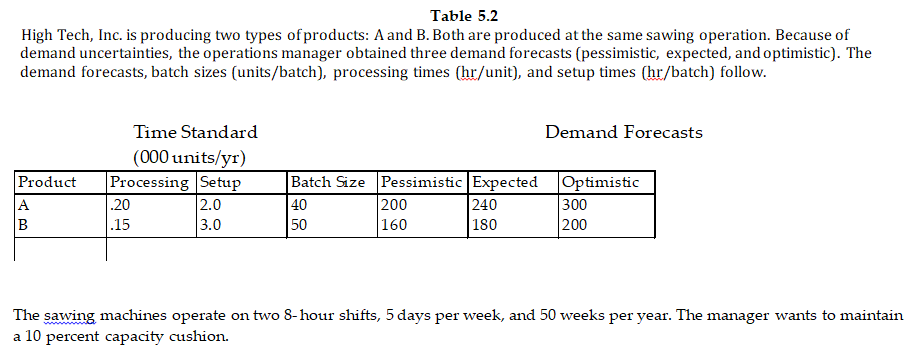
Using the information from Table 5.2, how many hours of capacity can the company expect from each of its sawing machines?
A) less than 3500 hours
B) more than 3500 hours but less than 3700 hours
C) more than 3700 hours but less than 3900 hours
D) more than 3900 hours

Unlock Deck
Unlock for access to all 143 flashcards in this deck.
Unlock Deck
k this deck
21
John Owen owns a drugstore that is experiencing significant growth. Owen is trying to decide whether to expand its capacity, which currently is $200,000 in sales per quarter. Sales are seasonal. Forecasts of capacity requirements, expressed in sales per quarter for the next year, follow.

Owen is considering expanding capacity to the $250,000 level in sales per quarter. The before- tax profit margin from additional sales is 15 percent. How much would before- tax profits increase next year because of this expansion?
A) less than $15,000
B) more than $15,000 but less than $16,000
C) more than $16,000 but less than $17,000
D) more than $17,000

Owen is considering expanding capacity to the $250,000 level in sales per quarter. The before- tax profit margin from additional sales is 15 percent. How much would before- tax profits increase next year because of this expansion?
A) less than $15,000
B) more than $15,000 but less than $16,000
C) more than $16,000 but less than $17,000
D) more than $17,000

Unlock Deck
Unlock for access to all 143 flashcards in this deck.
Unlock Deck
k this deck
22
Which one of the following statements about capacity is best?
A) Short- term capacity plans deal with investments in new facilities and equipment.
B) Capacity is the average rate of output for a facility.
C) A line flow process usually measures its capacity in terms of output rates.
D) The utilization rate is expressed as the ratio of maximum output rate to capacity.
A) Short- term capacity plans deal with investments in new facilities and equipment.
B) Capacity is the average rate of output for a facility.
C) A line flow process usually measures its capacity in terms of output rates.
D) The utilization rate is expressed as the ratio of maximum output rate to capacity.

Unlock Deck
Unlock for access to all 143 flashcards in this deck.
Unlock Deck
k this deck
23
The lock box department at Bank 21 handles the processing of monthly loan payments to the bank, monthly and quarterly premium payments to a local insurance company, and bill payments for 85 of the bank's largest commercial customers. The payments are processed by machine operators, with one operator per machine. An operator can process one payment in 0.25 minute. Setup times are negligible in this situation. A capacity cushion of 20 percent is needed for the operation. The average monthly (not annual) volume of payments processed through the department currently is 400,000. However, it is expected to increase by 20 percent. The department operates eight hours per shift, two shifts per day, 260 days per year. How many machines (not operators) are needed to satisfy the new total processing volume? (Round up to the next whole integer.)
A) less than 7
B) 7
C) 8
D) more than 8
A) less than 7
B) 7
C) 8
D) more than 8

Unlock Deck
Unlock for access to all 143 flashcards in this deck.
Unlock Deck
k this deck
24
If a system is well balanced, which one of the following changes usually calls for a smaller- capacity cushion?
A) more of a flexible flow strategy
B) higher yield losses
C) higher capital intensity
D) higher customization
A) more of a flexible flow strategy
B) higher yield losses
C) higher capital intensity
D) higher customization

Unlock Deck
Unlock for access to all 143 flashcards in this deck.
Unlock Deck
k this deck
25
Little's Law is a mathematical expression for relating
A) the average throughput time to work- in- process (WIP) inventory and the actual output rate.
B) the utilization of a process to actual output and capacity.
C) the utilization of a process to work- in- process (WIP) inventory and the actual output rate.
D) the average throughput time for a process to actual output and capacity.
A) the average throughput time to work- in- process (WIP) inventory and the actual output rate.
B) the utilization of a process to actual output and capacity.
C) the utilization of a process to work- in- process (WIP) inventory and the actual output rate.
D) the average throughput time for a process to actual output and capacity.

Unlock Deck
Unlock for access to all 143 flashcards in this deck.
Unlock Deck
k this deck
26
If a system is well balanced, which one of the following changes usually calls for a larger- capacity cushion?
A) higher worker flexibility
B) requests for fast delivery times
C) higher inventories
D) higher capital intensity
A) higher worker flexibility
B) requests for fast delivery times
C) higher inventories
D) higher capital intensity

Unlock Deck
Unlock for access to all 143 flashcards in this deck.
Unlock Deck
k this deck
27
Which of the following descriptions about waiting line models is best?
A) They account for the random, independent behaviour of many customers.
B) They deal with the certainty and stability in demand.
C) They account for major events such as competitor actions.
D) They assume that each branch can give the highest expected payoff.
A) They account for the random, independent behaviour of many customers.
B) They deal with the certainty and stability in demand.
C) They account for major events such as competitor actions.
D) They assume that each branch can give the highest expected payoff.

Unlock Deck
Unlock for access to all 143 flashcards in this deck.
Unlock Deck
k this deck
28

Using the information in Table 5.4, if Lee expands the capacity to an equivalent of $360,000 sales now (year 0), and then expands the capacity to an equivalent of $400,000 sales at the beginning of year 4, how much would pretax cash flow increase in total for all years (years 1 through 5)?
A) less than $30,000
B) more than $30,000 but less than $40,000
C) more than $40,000 but less than $50,000
D) more than $50,000

Unlock Deck
Unlock for access to all 143 flashcards in this deck.
Unlock Deck
k this deck
29
Which one of the following factors usually calls for a LARGER capacity cushion?
A) high worker flexibility
B) more reliable equipment
C) high capital intensity
D) uncertain demand
A) high worker flexibility
B) more reliable equipment
C) high capital intensity
D) uncertain demand

Unlock Deck
Unlock for access to all 143 flashcards in this deck.
Unlock Deck
k this deck
30
Which one of the following statements about capacity cushion is best?
A) A larger cushion increases manufacturing lead time.
B) Businesses find large cushions appropriate when demand varies.
C) A larger cushion increases equipment utilization when capital intensity is high.
D) A larger cushion is required when a firm uses low cost as a competitive priority.
A) A larger cushion increases manufacturing lead time.
B) Businesses find large cushions appropriate when demand varies.
C) A larger cushion increases equipment utilization when capital intensity is high.
D) A larger cushion is required when a firm uses low cost as a competitive priority.

Unlock Deck
Unlock for access to all 143 flashcards in this deck.
Unlock Deck
k this deck
31
Which one of the following statements explaining some aspect of economies of scale is best?
A) A larger facility usually has a smaller total fixed cost.
B) With higher volumes, the process shifts toward flexible flows, with resources dedicated to individual products.
C) A 100- bed hospital costs more to build than twice the cost of a 50- bed hospital.
D) Dedicating resources to individual products reduces changeovers and setups.
A) A larger facility usually has a smaller total fixed cost.
B) With higher volumes, the process shifts toward flexible flows, with resources dedicated to individual products.
C) A 100- bed hospital costs more to build than twice the cost of a 50- bed hospital.
D) Dedicating resources to individual products reduces changeovers and setups.

Unlock Deck
Unlock for access to all 143 flashcards in this deck.
Unlock Deck
k this deck
32
Which one of the following statements about measuring capacity is best?
A) The maximum output rate for a restaurant would be the number of seats.
B) Output measures are the usual choice for flexible flow processes.
C) The utilization rate is expressed as the ratio of average output rate to either peak capacity or effective capacity.
D) Input measures are the usual choice of firms like Nissan Motor Company at its Tennessee plant.
A) The maximum output rate for a restaurant would be the number of seats.
B) Output measures are the usual choice for flexible flow processes.
C) The utilization rate is expressed as the ratio of average output rate to either peak capacity or effective capacity.
D) Input measures are the usual choice of firms like Nissan Motor Company at its Tennessee plant.

Unlock Deck
Unlock for access to all 143 flashcards in this deck.
Unlock Deck
k this deck
33

Use the information in Table 5.3 to help answer this question. Currently, the company has 12 MASAC27A machines, and financial constraints prevent any expansion for the next year. Which one of the following alternatives will allow next year's demand to be fully covered?
A) Increase the batch size of product B to 300 units.
B) Decrease the capacity cushion by 1 percent.
C) Increase the capacity cushion to 30 percent.
D) Do nothing.

Unlock Deck
Unlock for access to all 143 flashcards in this deck.
Unlock Deck
k this deck
34
Sleep Tight Motel has the opportunity to purchase an adjacent plot of land. Building on this land would increase their capacity from the current sales level of $515,000/year to $600,000/year. Sleep Tight experiences a 20 percent before- tax profit margin. It wishes to estimate the additional before- tax profits that the expansion will produce. Using the following information, how much more before- tax cash flow would be realized just in the year 10 alone? 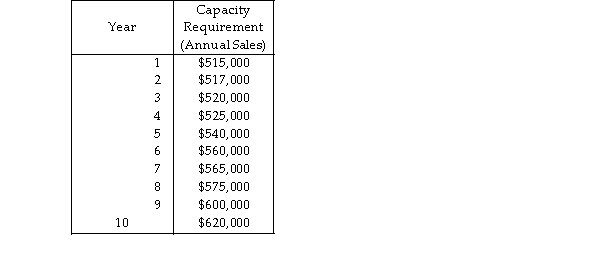
A) less than or equal to $20,000
B) greater than $20,000 but less than or equal to $25,000
C) greater than $25,000 but less than or equal to $30,000
D) greater than 30,000

A) less than or equal to $20,000
B) greater than $20,000 but less than or equal to $25,000
C) greater than $25,000 but less than or equal to $30,000
D) greater than 30,000

Unlock Deck
Unlock for access to all 143 flashcards in this deck.
Unlock Deck
k this deck
35
Which one of the following statements about measuring capacity is best?
A) A line flow process usually measures its capacity in terms of output rates.
B) The utilization rate is expressed as the ratio of maximum output rate to capacity.
C) Peak capacity is the output that a facility can sustain under normal conditions.
D) The minimum output rate for a restaurant would be the number of seats.
A) A line flow process usually measures its capacity in terms of output rates.
B) The utilization rate is expressed as the ratio of maximum output rate to capacity.
C) Peak capacity is the output that a facility can sustain under normal conditions.
D) The minimum output rate for a restaurant would be the number of seats.

Unlock Deck
Unlock for access to all 143 flashcards in this deck.
Unlock Deck
k this deck
36
Many alternative strategies are available for the timing and sizing decision in capacity expansion. Which one of the following statements regarding these strategies is best?
A) The expansionist strategy makes large, frequent jumps.
B) The expansionist strategy involves large, infrequent jumps in capacity.
C) Lost sales are more likely when the expansionist strategy is adopted.
D) The wait- and- see strategy makes large, infrequent jumps.
A) The expansionist strategy makes large, frequent jumps.
B) The expansionist strategy involves large, infrequent jumps in capacity.
C) Lost sales are more likely when the expansionist strategy is adopted.
D) The wait- and- see strategy makes large, infrequent jumps.

Unlock Deck
Unlock for access to all 143 flashcards in this deck.
Unlock Deck
k this deck
37
A company's production facility, consisting of two identical machines, currently caters only to product A. The annual demand for the product is 4000 units. Management has now decided to introduce another product, B, which uses the same facilities as that of product A. Product B has an annual demand of 2000 units. In view of the uncertainties involved in producing two products, management desires to have an overall 10 percent capacity cushion. Given the following additional information, how many more machines are required? (Assume 8 hours/shift, 2 shifts/day, 250 days/year, and that no overtime is allowed.) 
A) One additional machine is necessary.
B) No additional machines are necessary.
C) More than two additional machines are necessary.
D) Two additional machines are necessary.

A) One additional machine is necessary.
B) No additional machines are necessary.
C) More than two additional machines are necessary.
D) Two additional machines are necessary.

Unlock Deck
Unlock for access to all 143 flashcards in this deck.
Unlock Deck
k this deck
38
Which one of the following statements concerning capacity cushions is best?
A) Capacity cushions are used primarily in manufacturing organizations, not in service organizations.
B) Large- capacity cushions are utilized more often when future demand is level and known.
C) Small cushions are used in organizations where the products and services produced often change.
D) Small- capacity cushions are used extensively in capital- intensive firms.
A) Capacity cushions are used primarily in manufacturing organizations, not in service organizations.
B) Large- capacity cushions are utilized more often when future demand is level and known.
C) Small cushions are used in organizations where the products and services produced often change.
D) Small- capacity cushions are used extensively in capital- intensive firms.

Unlock Deck
Unlock for access to all 143 flashcards in this deck.
Unlock Deck
k this deck
39
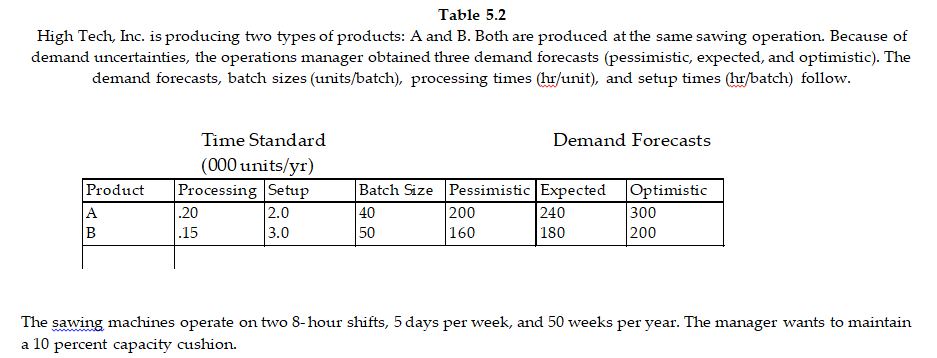
Using the information from Table 5.2, what is the minimum number of machines needed (assuming no reliance on short- term options)?
A) less than or equal to 22
B) more than 22 but less than or equal to 25
C) more than 25 but less than or equal to 28
D) more than 28

Unlock Deck
Unlock for access to all 143 flashcards in this deck.
Unlock Deck
k this deck
40
Which one of the following statements about capacity is best?
A) Companies with high capital costs tend to have large- capacity cushions.
B) Companies that have considerable customization tend to have larger- capacity cushions.
C) Companies with flexible flow processes tend to have small- capacity cushions.
D) Constant demand rates require larger- capacity cushions.
A) Companies with high capital costs tend to have large- capacity cushions.
B) Companies that have considerable customization tend to have larger- capacity cushions.
C) Companies with flexible flow processes tend to have small- capacity cushions.
D) Constant demand rates require larger- capacity cushions.

Unlock Deck
Unlock for access to all 143 flashcards in this deck.
Unlock Deck
k this deck
41
______ is the maximum rate of output for a process.

Unlock Deck
Unlock for access to all 143 flashcards in this deck.
Unlock Deck
k this deck
42
The ______ strategy refers to a condition which involves smaller, more frequent jumps in capacity.

Unlock Deck
Unlock for access to all 143 flashcards in this deck.
Unlock Deck
k this deck
43
The total time that a typical item spends in any process, termed ______ time, increases as the average level of inventor in that process increases.

Unlock Deck
Unlock for access to all 143 flashcards in this deck.
Unlock Deck
k this deck
44

Use the information in Table 5.3 to help answer this question. Additionally, the company works 250 days every year and operates 2 shifts, each of which covers 8 hours. If a 25 percent capacity cushion is maintained, how many machines does the company need next year to fully cover the demand?
A) less than 13 machines
B) 13 machines
C) 14 machines
D) more than 14 machines

Unlock Deck
Unlock for access to all 143 flashcards in this deck.
Unlock Deck
k this deck
45
The Northern Manufacturing Company is producing two types of products: A and B. Demand forecasts for next year and other production- related information are provided in the following table:

Both of these products are produced at the same workstation, called the Automatic Lathe. Currently, the company has 12 automatic lathes, and financial constraints prevent any expansion for the next year. It works 250 days per year with two 8- hour shifts and desires a 25 percent capacity cushion. Which one of the following alternatives will allow next year's demand to be fully covered?
A) Decrease the capacity cushion by 1 percent.
B) Increase the capacity cushion to 30 percent.
C) Increase the batch size of product B to 300 units.
D) Do nothing.

Both of these products are produced at the same workstation, called the Automatic Lathe. Currently, the company has 12 automatic lathes, and financial constraints prevent any expansion for the next year. It works 250 days per year with two 8- hour shifts and desires a 25 percent capacity cushion. Which one of the following alternatives will allow next year's demand to be fully covered?
A) Decrease the capacity cushion by 1 percent.
B) Increase the capacity cushion to 30 percent.
C) Increase the batch size of product B to 300 units.
D) Do nothing.

Unlock Deck
Unlock for access to all 143 flashcards in this deck.
Unlock Deck
k this deck
46
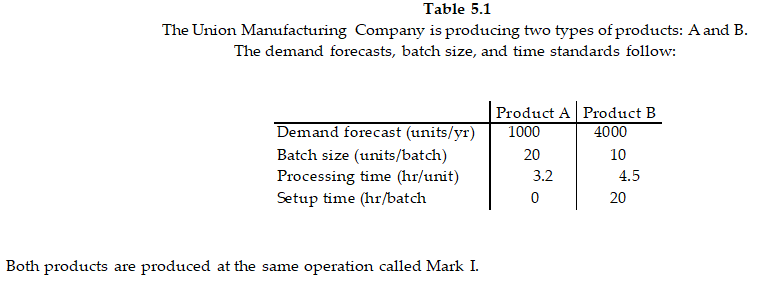
Use the information in Table 5.1. The company works 250 days per year and operates two shifts, each covering 8 hours. If a 15 percent capacity cushion is maintained, how many hours of capacity can the company expect from each of its Mark I machines?
A) less than 3000
B) between 3000 and 3500
C) between 3501 and 4000
D) more than 4000

Unlock Deck
Unlock for access to all 143 flashcards in this deck.
Unlock Deck
k this deck
47
Capacity decisions are usually linked with other decision areas. If a system is well balanced, which one of the following changes requires a larger- capacity cushion?
A) The capital intensity of the process is increased.
B) Yield losses in the production process are reduced.
C) The company promises faster delivery times to customers.
D) Schedules for production are more stable.
A) The capital intensity of the process is increased.
B) Yield losses in the production process are reduced.
C) The company promises faster delivery times to customers.
D) Schedules for production are more stable.

Unlock Deck
Unlock for access to all 143 flashcards in this deck.
Unlock Deck
k this deck
48
The ______ strategy refers to a condition which involves large, infrequent jumps in capacity.

Unlock Deck
Unlock for access to all 143 flashcards in this deck.
Unlock Deck
k this deck
49
A(n) ______ is an operation that has the lowest effective capacity of any operation in the process, and thus limits the system's output.

Unlock Deck
Unlock for access to all 143 flashcards in this deck.
Unlock Deck
k this deck
50
Define the following two terms: peak capacity and effective capacity.

Unlock Deck
Unlock for access to all 143 flashcards in this deck.
Unlock Deck
k this deck
51
Which one of the following factors usually motivates a SMALLER capacity cushion?
A) unevenly distributed demands
B) high penalty costs for overtime usage
C) requests for quick customer services
D) high capital intensity
A) unevenly distributed demands
B) high penalty costs for overtime usage
C) requests for quick customer services
D) high capital intensity

Unlock Deck
Unlock for access to all 143 flashcards in this deck.
Unlock Deck
k this deck
52
______ is the degree to which equipment, space, or labor is currently being used.

Unlock Deck
Unlock for access to all 143 flashcards in this deck.
Unlock Deck
k this deck
53
Define each of the following capacity strategies: expansionist, and wait- and- see.

Unlock Deck
Unlock for access to all 143 flashcards in this deck.
Unlock Deck
k this deck
54
______ capacity is the maximum output that a process or facility can achieve under ideal conditions.

Unlock Deck
Unlock for access to all 143 flashcards in this deck.
Unlock Deck
k this deck
55
______ is the amount of reserve capacity that a firm maintains to handle a sudden increase in demand or temporary losses of production capacity.

Unlock Deck
Unlock for access to all 143 flashcards in this deck.
Unlock Deck
k this deck
56
______ capacity is the maximum output that a process or firm can economically sustain under normal conditions.

Unlock Deck
Unlock for access to all 143 flashcards in this deck.
Unlock Deck
k this deck
57
The ______ is to do nothing and simply lose orders from any demand that exceeds current capacity.

Unlock Deck
Unlock for access to all 143 flashcards in this deck.
Unlock Deck
k this deck
58
Which one of the following statements about capacity expansion is best?
A) The follow- the- leader strategy can help a firm gain a competitive advantage.
B) The expansionist strategy minimizes risk.
C) The wait- and- see strategy involves small jumps in capacity compared to the expansionist strategy.
D) The expansionist strategy involves frequent jumps in capacity compared to the wait- and- see strategy.
A) The follow- the- leader strategy can help a firm gain a competitive advantage.
B) The expansionist strategy minimizes risk.
C) The wait- and- see strategy involves small jumps in capacity compared to the expansionist strategy.
D) The expansionist strategy involves frequent jumps in capacity compared to the wait- and- see strategy.

Unlock Deck
Unlock for access to all 143 flashcards in this deck.
Unlock Deck
k this deck
59
The maximum output that a process or facility can achieve under ideal conditions is referred to as the
A) throughput time.
B) utilization.
C) effective capacity.
D) peak capacity.
A) throughput time.
B) utilization.
C) effective capacity.
D) peak capacity.

Unlock Deck
Unlock for access to all 143 flashcards in this deck.
Unlock Deck
k this deck
60
An expansionist strategy in regard to capacity is best characterized by
A) reducing the risks of overly optimistic demand forecasts.
B) emphasizing flexibility and quality while foregoing the larger market share of the lowest- cost producers.
C) using capacity to increase a firm's market share or to act as a form of preemptive market.
D) expanding only when others do.
A) reducing the risks of overly optimistic demand forecasts.
B) emphasizing flexibility and quality while foregoing the larger market share of the lowest- cost producers.
C) using capacity to increase a firm's market share or to act as a form of preemptive market.
D) expanding only when others do.

Unlock Deck
Unlock for access to all 143 flashcards in this deck.
Unlock Deck
k this deck
61
is any stock of items used to support the production of goods and services or
satisfy customer demand.
satisfy customer demand.

Unlock Deck
Unlock for access to all 143 flashcards in this deck.
Unlock Deck
k this deck
62
Process Management Triangle is made up of capacity utilization, ______ and ______ .

Unlock Deck
Unlock for access to all 143 flashcards in this deck.
Unlock Deck
k this deck
63
What is a decision tree?

Unlock Deck
Unlock for access to all 143 flashcards in this deck.
Unlock Deck
k this deck
64
The ______ time for a specific item as it moves through a process can be found by adding the operations, movement and wait times.

Unlock Deck
Unlock for access to all 143 flashcards in this deck.
Unlock Deck
k this deck
65
The theory of constraints is an approach to management that focuses on whatever impedes progress toward the goal of maximizing the flow of total value- added funds or sales less discounts and variable costs.

Unlock Deck
Unlock for access to all 143 flashcards in this deck.
Unlock Deck
k this deck
66
What is a waiting line model, and what information can it provide?

Unlock Deck
Unlock for access to all 143 flashcards in this deck.
Unlock Deck
k this deck
67
Two factors favor an expansionist strategy in capacity decisions: expansion may help achieve ______ of scale, and it may also ______ the learning rate.

Unlock Deck
Unlock for access to all 143 flashcards in this deck.
Unlock Deck
k this deck
68
What is the meaning of diseconomies of scale, and what are two ways for a firm to avoid them?

Unlock Deck
Unlock for access to all 143 flashcards in this deck.
Unlock Deck
k this deck
69
What are the four steps involved in making capacity decisions?

Unlock Deck
Unlock for access to all 143 flashcards in this deck.
Unlock Deck
k this deck
70
______ is a concept that states that the average unit cost of a good or service can be reduced by increasing its output.

Unlock Deck
Unlock for access to all 143 flashcards in this deck.
Unlock Deck
k this deck
71
More complex waiting- line problems must be analyzed with _______ .

Unlock Deck
Unlock for access to all 143 flashcards in this deck.
Unlock Deck
k this deck
72
The ______ time is the time required to change an operation from making one type of product or service to making another.

Unlock Deck
Unlock for access to all 143 flashcards in this deck.
Unlock Deck
k this deck
73
The higher that process variability is, the more expensive and difficult the process is to manage.

Unlock Deck
Unlock for access to all 143 flashcards in this deck.
Unlock Deck
k this deck
74
capacity plans focus on workforce size, overtime budgets, and inventories.

Unlock Deck
Unlock for access to all 143 flashcards in this deck.
Unlock Deck
k this deck
75
If demand is increasing, and you also prefer to increase the time between capacity increments, then the size of increments should ______ .

Unlock Deck
Unlock for access to all 143 flashcards in this deck.
Unlock Deck
k this deck
76
______ is introduced by chance and results from small changes or differences in equipment operations, people's behaviour, or environmental conditions.

Unlock Deck
Unlock for access to all 143 flashcards in this deck.
Unlock Deck
k this deck
77
Give four principal reasons why economies of scale can occur when output increases.

Unlock Deck
Unlock for access to all 143 flashcards in this deck.
Unlock Deck
k this deck
78
Little's Law is the mathematical relationship than computes the average throughput time for items based on ______ inventory and the actual output rate.

Unlock Deck
Unlock for access to all 143 flashcards in this deck.
Unlock Deck
k this deck
79
Capacity gap is an addition to projected demand and current capacity.

Unlock Deck
Unlock for access to all 143 flashcards in this deck.
Unlock Deck
k this deck
80
If customer demand exceeds process capacity, every operation with capacity utilization greater than 100 percent is an external bottleneck.

Unlock Deck
Unlock for access to all 143 flashcards in this deck.
Unlock Deck
k this deck



